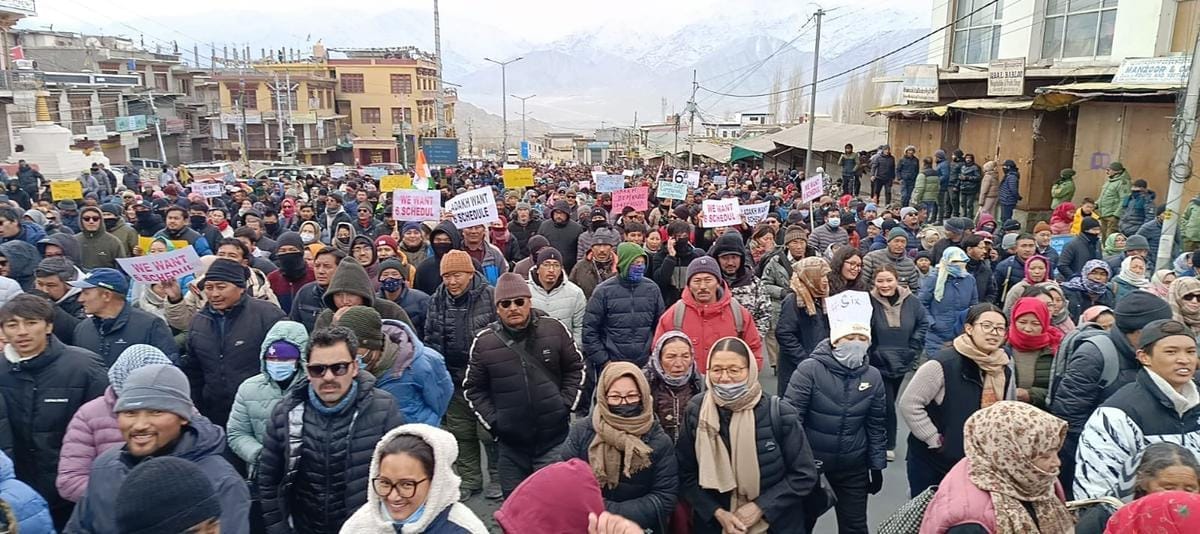Ladakh Statehood Protests Turn Violent: A Deep Dive Into the Crisis

The usually serene Himalayan region of Ladakh is witnessing one of its worst bouts of unrest since it was carved out of Jammu & Kashmir in 2019 and made a Union Territory (UT). What began as peaceful demonstrations demanding statehood and Sixth Schedule status has turned deadly, with at least four protesters killed and over 50 injured in Leh following violent clashes with security forces.
As curfew grips Leh and tensions rise, the Centre, the Union Territory administration, and activists trade blame, leaving residents caught between political promises and growing frustration.
🔴 What Happened in Leh?
Protests Escalate: Thousands of Ladakhis, led by local groups such as the Apex Body Leh and the Kargil Democratic Alliance (KDA), gathered in Leh demanding statehood, constitutional safeguards under the Sixth Schedule, job reservations, and land protection.
Violence Erupts: The agitation spiraled out of control on September 24, 2025, as a section of protesters clashed with security forces. Reports indicate stone pelting, arson, and vandalism in parts of Leh.
BJP Office Torched: Angry protesters set fire to the BJP district office, alleging betrayal on promises made since 2019.
Police Firing: Security personnel reportedly opened fire after failing to disperse the crowd, leading to four confirmed deaths and several critically injured.
Curfew Imposed: Authorities imposed curfew and prohibitory orders across Leh, suspending mobile internet to prevent further escalation.
⚖️ The Demands of the Protesters
Full Statehood: Ladakh was granted Union Territory status in 2019, but without a legislature. Protesters argue this has left them without democratic representation.
Sixth Schedule Inclusion: Ladakhis want constitutional protections to safeguard their land, jobs, and culture, similar to tribal areas in the Northeast.
Job Security: Local youth accuse the administration of favoring outsiders in government jobs, worsening the employment crisis.
Environmental & Cultural Safeguards: Activists highlight the fragile ecology of Ladakh and the need for local decision-making.
🔥 Why Did the Protests Turn Violent?
Different stakeholders are pointing fingers:
Government’s Stand: The Union Home Ministry accused activist Sonam Wangchuk of making “provocative remarks” referencing the Arab Spring and calling the movement a “Gen Z revolution,” which allegedly incited violence.
Opposition’s View: Congress and other opposition parties claim the unrest is the result of broken promises by the BJP, especially after assurances of safeguarding Ladakh’s interests post-Article 370 abrogation.
Wangchuk’s Clarification: Sonam Wangchuk, who had been on a 15-day hunger strike for non-violent protests, distanced himself from the violence, saying, “I don’t want more trouble. The government forced peaceful protesters into frustration.”
Locals’ Anger: Residents argue that delays in dialogue, lack of representation, and job insecurity pushed youth towards agitation.
🧭 Political Blame Game
BJP: Alleged that the violence was orchestrated by Congress supporters to destabilize Ladakh.
Congress: Accused the BJP of failing Ladakh’s people after raising expectations in 2019.
Ladakh LG (Lt Governor): Claimed attempts were made to even target CRPF personnel, calling the unrest a “planned conspiracy.”
Civil Society: Apex Body Leh and KDA urged restraint but blamed the Centre for ignoring peaceful negotiations.
📌 Key Developments So Far
Four Dead, Dozens Injured: Violence claimed four lives; over 50 are being treated for injuries.
Curfew Across Leh: Markets, schools, and offices remain shut. Internet suspended.
Centre’s Response: MHA has said the situation is “under control” and sent a team of officials to Leh for review.
Wangchuk Ends Hunger Strike: The activist called off his fast amid fears of further violence, appealing to youth to maintain peace.
Opposition Reaction: Parties including Congress, NC, and PDP said the issue must be handled with “sensitivity, not force.”
🌍 Why Ladakh Is at Boiling Point
Since 2019, Ladakhis have felt increasingly marginalized:
No legislative assembly unlike other UTs (Delhi, Puducherry).
Lack of constitutional protection for land and jobs.
Unemployment crisis due to limited industries and shrinking opportunities in government sectors.
Rising concerns about cultural identity and environmental degradation as Ladakh opens up to outside investments.
🔮 What Next for Ladakh?
Dialogue or Crackdown? The Centre says talks are ongoing, but trust between locals and the government is at its lowest.
Role of Wangchuk: As the face of the protest, Wangchuk may either bridge the gap with authorities or be sidelined by politics.
Future of Sixth Schedule Demand: The government has so far avoided committing, but unrest may push them to reconsider.
Impact on 2025 Politics: With Ladakh protests turning into a national issue, both BJP and Congress will use it to sway public opinion.
📝 Conclusion
The Ladakh protests reflect a deeper crisis of trust between people and the state. What began as a peaceful demand for representation and protection has now turned into a violent confrontation, costing lives and damaging property.
Whether this moment will mark the beginning of genuine dialogue or a cycle of unrest depends on how sensitively the Centre handles Ladakh’s aspirations.
Press Release on Our All Websites for Powerful Online Presence
Get your brand featured with a world-class press release, published across all our high-authority websites — complete with powerful do-follow backlinks. Crafted to meet global press release standards, our service ensures maximum credibility, visibility, and SEO impact. Special pricing and exclusive offers are available for a limited time. Contact us today at sunil@justbaazaar.com to elevate your brand’s presence."
Created with ©systeme.io









